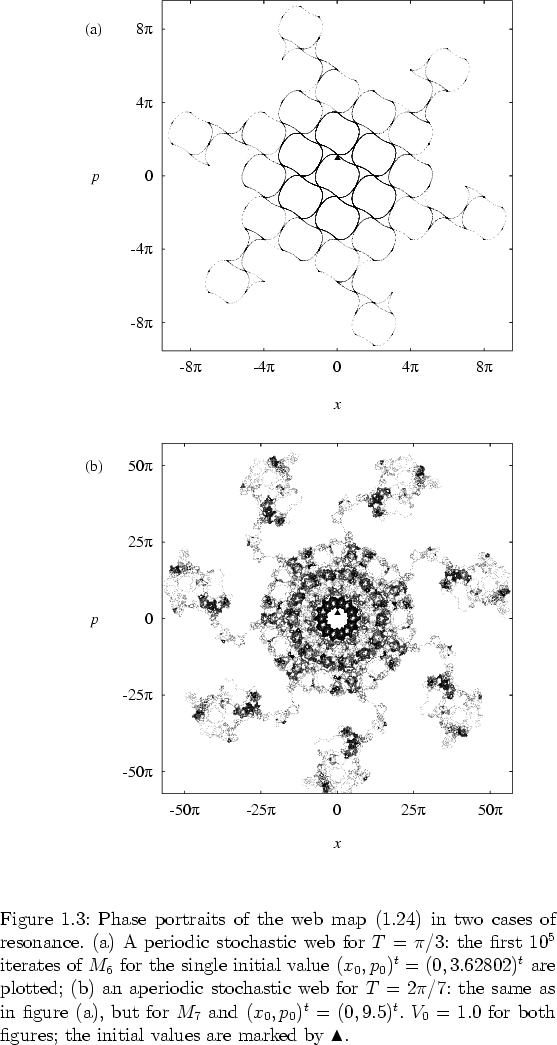
Two examples of stochastic webs that are generated by the web map (1.24) are shown in figure 1.3.
The figures each show the first
Certain
(approximate)
symmetry properties of the stochastic web
for ![]() are obvious:
in this particular case the web
is characterized by translational symmetry in two transversal directions
(e.g. given by
are obvious:
in this particular case the web
is characterized by translational symmetry in two transversal directions
(e.g. given by
![]() ) and
by rotational symmetry with respect to several classes of 2-fold
rotations, in addition to several reflection
and glide reflection
symmetries.
In fact it turns out that the underlying
skeleton
of the web is even invariant under
2-fold, 3-fold and 6-fold rotations
about
suitably chosen
centres of rotation.
See subsection 1.2.2 for
a rigorous definition of the skeletons of stochastic webs,
and for more information on the symmetry groups of these skeletons.
) and
by rotational symmetry with respect to several classes of 2-fold
rotations, in addition to several reflection
and glide reflection
symmetries.
In fact it turns out that the underlying
skeleton
of the web is even invariant under
2-fold, 3-fold and 6-fold rotations
about
suitably chosen
centres of rotation.
See subsection 1.2.2 for
a rigorous definition of the skeletons of stochastic webs,
and for more information on the symmetry groups of these skeletons.
In figure 1.3b, for ![]() (
(![]() ), the situation is
different:
although this phase portrait
still reveals
approximate
rotational invariance with respect to the origin
(rotations through the angle
), the situation is
different:
although this phase portrait
still reveals
approximate
rotational invariance with respect to the origin
(rotations through the angle ![]() ),
there is no
translational invariance
as
seen for example
in figure 1.3a.
In this sense,
the phase portrait in figure 1.3b is less
regular than that in figure 1.3a.
Webs in phase space with just rotational symmetry -- like the web for
),
there is no
translational invariance
as
seen for example
in figure 1.3a.
In this sense,
the phase portrait in figure 1.3b is less
regular than that in figure 1.3a.
Webs in phase space with just rotational symmetry -- like the web for
![]() -- are called aperiodic stochastic webs, as opposed to the
periodic stochastic webs
exhibiting
both
rotational and translational
symmetry, an example being the web for
-- are called aperiodic stochastic webs, as opposed to the
periodic stochastic webs
exhibiting
both
rotational and translational
symmetry, an example being the web for ![]() .
.
Having introduced
periodic and aperiodic stochastic webs, the
importance of the resonance condition (1.23) may now
be illustrated by considering a value of
![]() with noninteger
with noninteger ![]() .
Figure 1.4
shows a phase portrait of the POINCARÉ map
(1.21) for
.
Figure 1.4
shows a phase portrait of the POINCARÉ map
(1.21) for ![]() .
.
In
the following
subsection 1.2.1 I present an argument for the fact
that periodic webs,
characterized by both rotational and translational symmetries,
can develop not for all
![]() but only for a few
specific values of
but only for a few
specific values of ![]() , namely
for
, namely
for
I then proceed in subsection 1.2.2 to the discussion of the
skeleton, or ``backbone'', of the web and derive an equation that
determines this overall structure of the web. Finally, in subsections
1.2.3 and 1.2.4 I briefly give an
overview on what is known about the classical unbounded diffusive
dynamics within the channels of the web that form around its skeleton;
in particular I discuss
the typical
energy growth
of a diffusing particle and
the width of the channels of diffusive dynamics which is directly
controlled by the kick strength ![]() .
The results presented in subsections 1.2.2 and
1.2.3 are
mainly based on [ZSUC91].
.
The results presented in subsections 1.2.2 and
1.2.3 are
mainly based on [ZSUC91].